Islamic traditional architecture environment overlapping the modern architecture design
Ma Albeetar Rami
(School of Architecture, Southeast University, Nanjing 210096, China)
Islamic traditional architecture environment overlapping the modern architecture design
Ma Albeetar Rami
(School of Architecture, Southeast University, Nanjing 210096, China)
This paper investigates the purpose and the functions of buildings and their compatibility with Islamic culture and the environment. An analysis from ecological and environmental points of view is carried out. The challenge is how these traditional outlines can best fit the functions of the building and the facilities intended to be offered, and how the new building has satisfied the requirements of the traditional environment. The investigation also shows the increasing usage of modern design materials for the hospital, which does not offer sufficient heat insulation or reasonable lighting. Although the Mashiakhet Al Azhar and Dar El Eftaa establishments have completely different functions, their designs consider and recognize the environmental requirements and the historical background. The sites of the Mashiakhet Al Azhar and Dar El Eftaa compound have achieved complete harmony with the surrounding environment. The hospital may meet its utilitarian needs and functions, but lacks a general environmental and traditional balance with the whole district. However, functional and traditional aspects can be combined successfully at the same time.
Islamic environment; historical landscape; traditional outlines and environmental requirement
The architecture history of Egypt represents a range of the civilizations and cultures of the people in this region. It bears withess to ages of great supremacy and the dramatic decline of dynasties that ruled during a long history beginning from the ancient Egyptians to modern times. The Islamic architecture in Egypt has changed the previous famous architecture styles of Greece, Byzantium, Persia and Rome[1]. Islamic influence was a major contributing factor to architectural development in Andalusia and the whole of Europe during the Renaissance. Islamic architecture in essence encompassed a wide range of both secular and religious styles. Cairo as the capital of Islamic Egypt represented the dynasties of a long Islamic history since its establishment. Several quarters were distinguished by its Dynasty Style. The conservation of this heritage in such a historical town is, therefore, of vital importance, not only for Egyptians but also for humanity. Although this principle has been violated in many ages in several districts, the survival of many structures is still a great human legacy. The foundation of the Children’s Oncology Hospital is a violation of the principle of preservation of human heritage and its environment. This study has a comparative and an analytical purpose to show the degrees of difference in the dominant Islamic styles in the region.
1 Environmental Background
The core and the surroundings of Cairo City are the sum of several elements including the environmental, religious, economic, social and political. Islamic culture with its social and traditional character is one of the most important aspects that influence and characterize the region. Islam religion nature as the relation between God and the individual is forming a way of life with special respect to neighbors and the conservative attitudes of families. These characteristics are reflected in the dominant architectural types. The location of Cairo is under arid hot conditions, which has affected the urban and the architectural pattern. This pattern is clear in its adoption of some elements such as building thick walls, Malkafs, domes, courtyards, Mashrabia and the urban tissue including the organic system.
2 Historical Background
2.1 The Fatimid Dynasty
The city of Cairo has witnessed a sequence of historical events since its establishment by the Fatimid Commander Jawhar al Siqilli as a new quarter (969—973) in Fostat (the capital of Egypt since Islamic conquest by Amr Ibn El Ass in 640, which was founded beside the Babylon Fortress)[2].
During the Fatimid Dynasty, a number of magnificent buildings were constructed including the Al Azhar mosque, a famous mosque and at the same time the oldest university teaching the Islamic faith in its various sects. Other surviving Fatimid structures include the Mosque of Al Aqmar (1125) as well as the monumental gates of Cairo City walls commissioned by the powerful Fatemid Emir Vizer Badr Al Jamali. Beside these elegant constructions, elaborate funerary monuments were also founded. The houses were simple and closed, characterized by open courtyards and crooked entrances. Fountains were also erected in the courtyards together with the use of Malkaf (ventilation) and Mashrabia. It is worth to say that since the Fatimid became powerful, the city expanded gradually with each age, particularly in the architecture style, which are their imprints of Islamic art. This art in general is strongly affected by the Islamic faith and traditions and stands in harmony with climatic and environmental aspects. Islamic architecture elements facilitated codes of conduct within the multiple and historical contexts of the Islamic world.
2.2 The Mamluk Dynasty
The Mamluk Dynasty began at the end of the Ayubid dynasty of Saladin (1169—1252) after his outstanding triumphs over many crusaders campaigns. The reign of Mamluks (1250—1517)[3]marked a breathtaking flourishing of Islamic art which is most visible in old Cairo. Religious concepts offered them generous patterns of architecture and art with majestic domes, courtyards and soaring minarets spreading across the city. The Mamluk architecture’s decorative arts included enamel, gilded glass, inlaid metalwork, woodwork and textiles which flourished under their rule. They had a profound impact and influence around Mediterranean both in North (Europe) and South (African north coast). Distinguished Mamiluk rulers established a patronage of public and pious foundations including madarases (schools), mausolea, minarets and pemarestans hospitals[1].
3 Elements of the Architecture Style during the Fatimid and Mamiluk Dynasties
The Islamic architecture style during the Fatimid and Mamiluk Dynasties can be identified by the following elements (see Fig.1):
1) Minarates as towers and Mihrabs indicating qibla.
2) Sahn(courtyard).
3) Central fountains (Maida) used for ablutions.
4) Iwan to connect different sections.
5) Domes, vaults, moqarnas and arches.
6) The use of geometric shapes and repetitive art (Arabesque)
4 A Comparative Analytical Study of Modern Institutions
4.1 A case study of the Children’s Oncology Hospital
The hospital is located at a short distance from Cairo Fostat west of the Magra El Oyoun wall (Saladin Fortification) in the centre of a random urban district. The area of the building and surroundings is about 1.0×104m2. Three entrances lead to the main building. The site was also surrounded, mainly at the front, by tracts of green lawns and parking lots. In order to establish better surro-

(a)
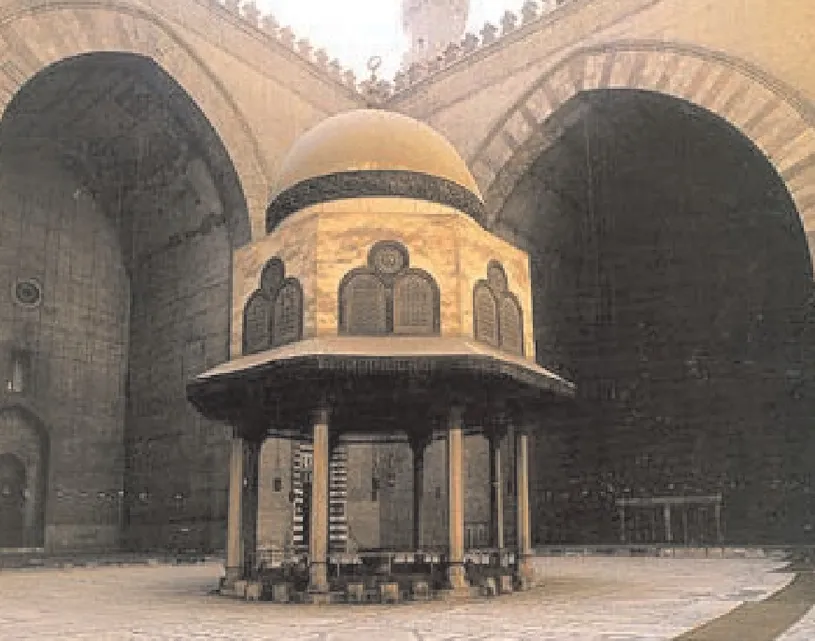
(b)

(c)

(d)
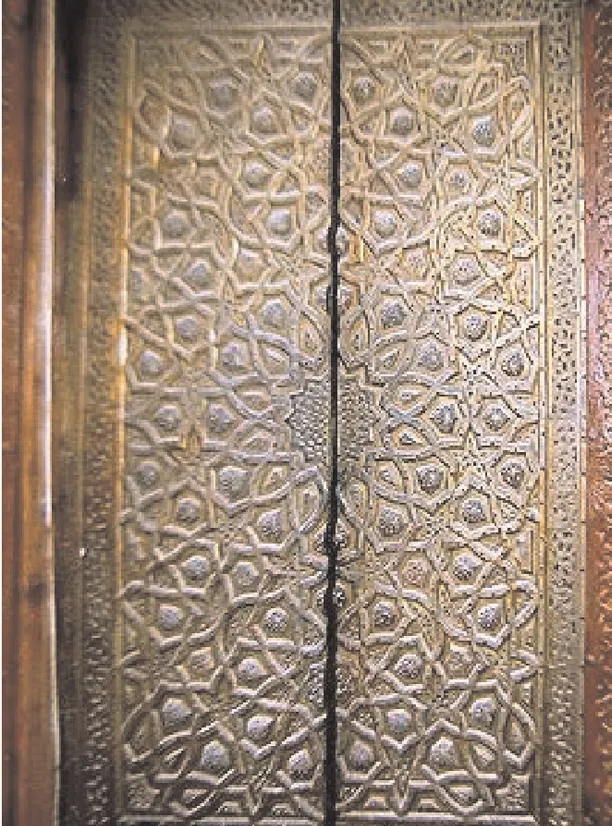
(e)

(f)
Fig.1 Fatemid interior design characteristics.(a) Use of ornaments; (b) Vaulted Iwans and a fountain in the middle of the sahn; (c) A style of window; (d) Use of calligraphy with arch and moqarnasat; (e) Use of Arabesque decoration; (f)Bright ornaments at Mihrab
undings, several unplanned (randomly planned) blocks of buildings and houses were demolished. However, the neighbouring areas consist of slaughter yards and their relevant industries creat a serious source of pollution(see Fig.2).
4.2 Hospital elements and components
The hospital is a building of eight stories with a total area of 1.0×104m2. Clinics, emergency rooms and the reception constitute the ground floor. These units are accessed by separate entrances from the main street. Other medical departments are distributed over the upper floors according to their functions. The hospital is provided with modern electromechanical systems including lighting, air conditioning, a computer network and an efficient system for water treatment and waste disposal, beside the highly sophisticated medical equipments (see Fig.3).
4.3 Conceptual design
The architecture concept adopted is to build a construction with integrated and functional facilities. The core was originally a block of Falluka (boat) form with its sails inspired by its location near the Nile River. The concept achieved the optimum level of service efficiency but failed to be in harmony with the prevailing Islamic style
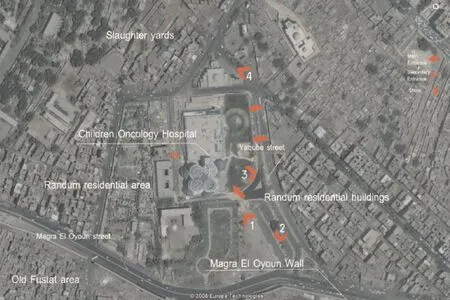
(a)

(b)
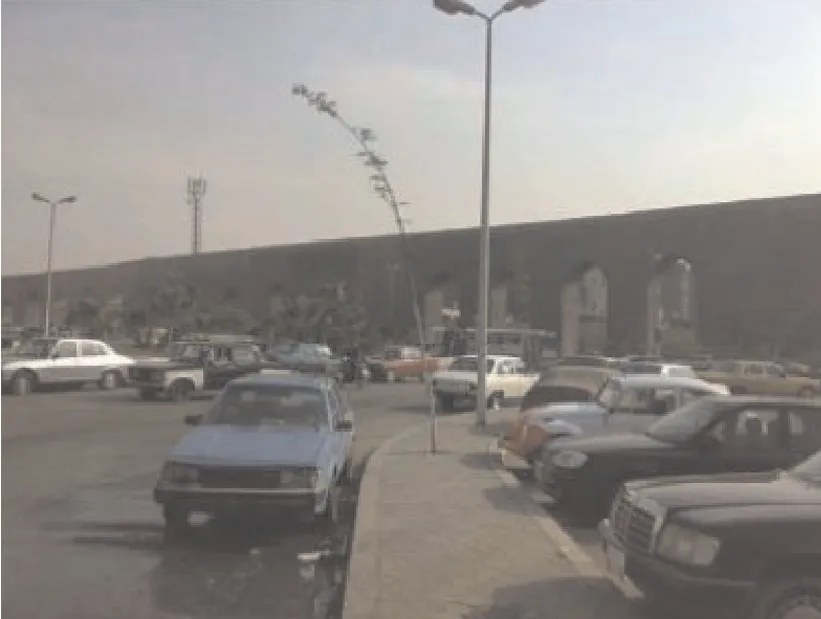
(c)
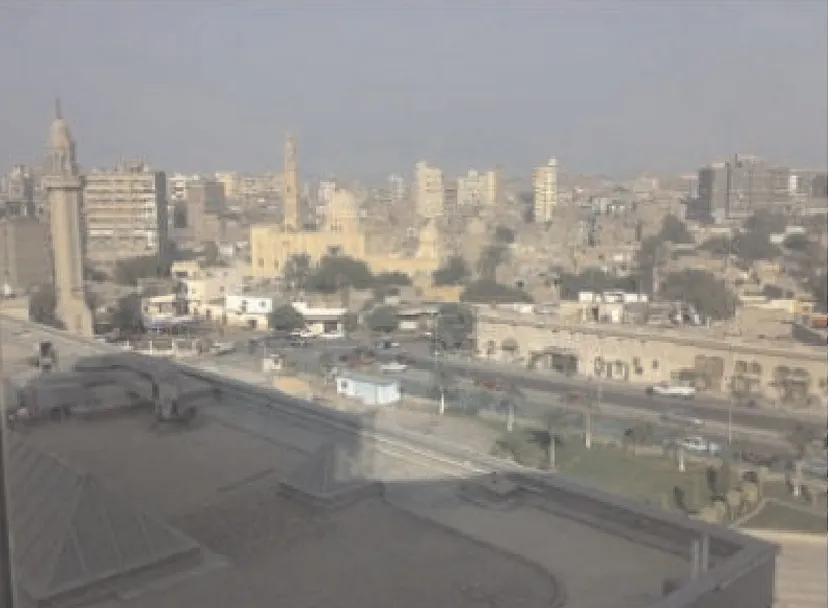
(d)

(e)
Fig.2 Site plan of the hospital area satellite image and surrounding streets and building frontal shots
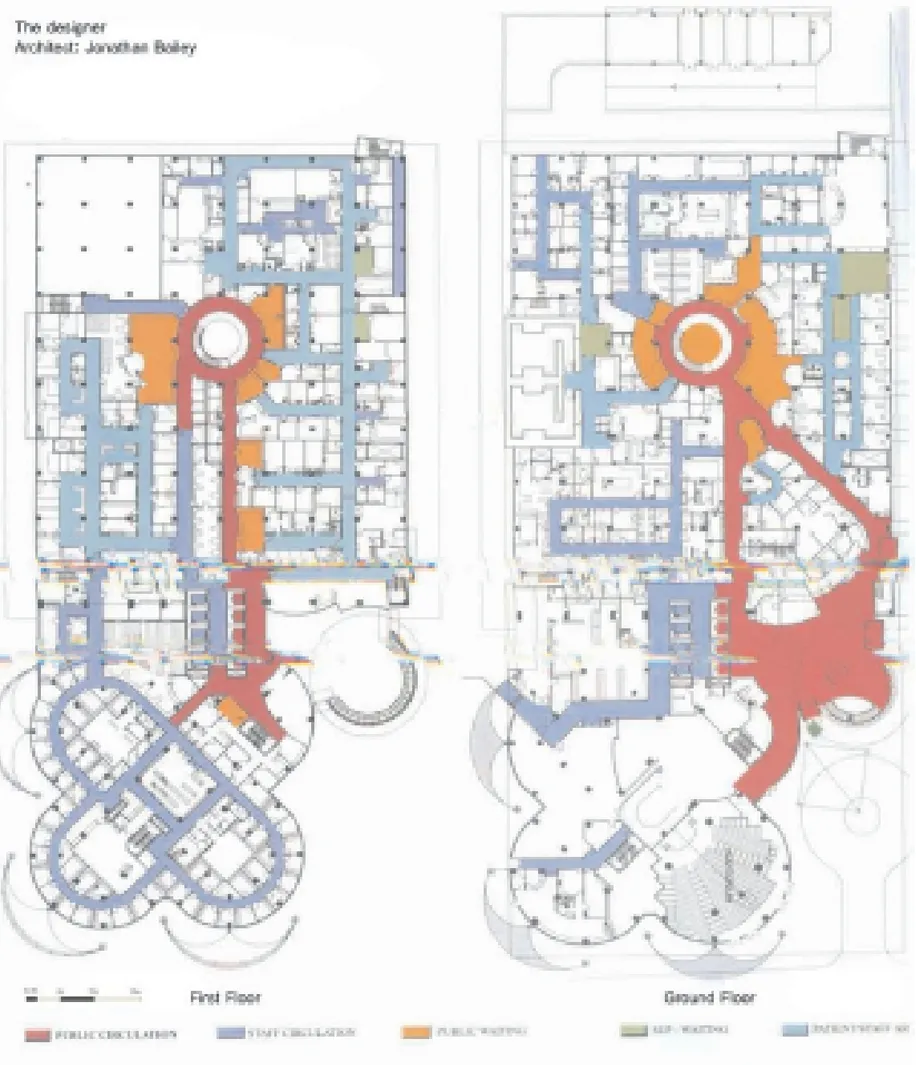
(a)
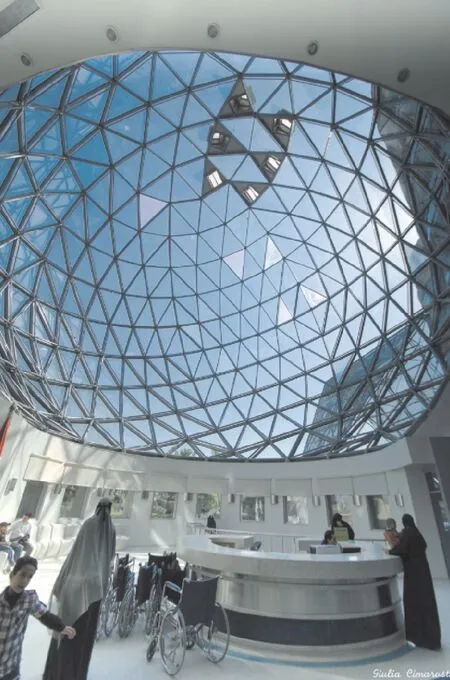
((b)
in the region. The designer (Jonathan Bailley)[4]created an architectural construction which appears a little strange for the environment. The establishment does not contain any Islamic elements and the main building is a mere block of Western style. The Islamic style, however, reveals a dynamic relation ship between the blocks and spaces. To introduce Islamic elements to a modern hospital is a great challenge for the designer who can be inspired by the surrounding Islamic architecture (see Fig.4).
The double-layered glass facades the hospital did not, in fact, accomplish shaded and/or air-conditioned interiors.

(a)
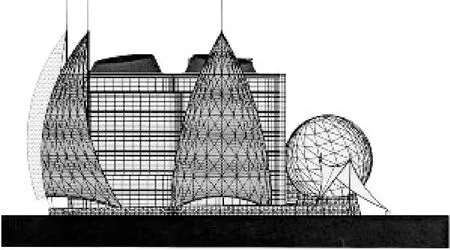
(b)
Curtains and centralized air-conditioning were extensively used. For attaining shade and light refraction, metal structures were used in many parts of the frontal facades. These structures included some parts which were called “sails”, quite different from any Islamic style in the surroundings.
Fewer openings of limited lengths are in the frontal facades of both Islamic constructions, and using Islamic features such as Mashrabiat, ornaments, finishing coloured materials, and other elements, this all came in harmony with the Islamic architectural style(see Fig.5).

(a)
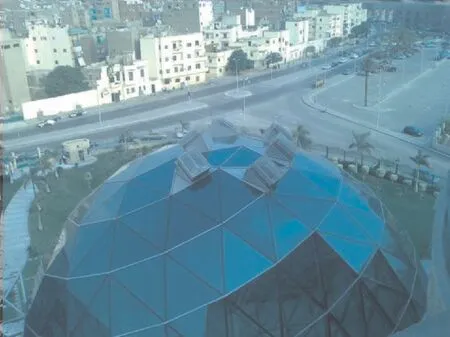
(b)
5 Compounds of Mashiakhet Al Azhar and DarEl Eftaa
This modern compound is replacing the separate old institutions of both buildings. These two institutions are under the control of the Al Azhar establishment. The first one (Mashiakhat Al Azhar) is the head-quarters of the grand Sheiks’ (Imams’) offices and the host of specialized centres for research, publications, faith dissemination, and international relations. The other one (Dar El Eftaa) is formally recognized as the only source of fatwas(interpretations of Islamic laws). The two institutions were formerly occupying the old buildings, but lacked enough space and suitable facades. These are the main reasons for having another site with enough space for several extended facilities.
The location of the Mashiakhet Al Azhar and Dar El Eftaa was chosen because the new structures in the region of the Fatimid Cairo are at a short distance from the Al Azhar Mosque (the famous Fatimid mosque in Cairo). The hilltop was elevated higher than the surrounding streets and grave-yards at the cross road of Salah Salim and Al Azhar street. The Islamic surrounding environment has had the greatest impact on the planning and architectural design of both buildings. The compound forms an engineering architectural model integrating all elements of Islamic architectural style and art, taking into general consideration the historical Islamic landscape (see Fig.6).
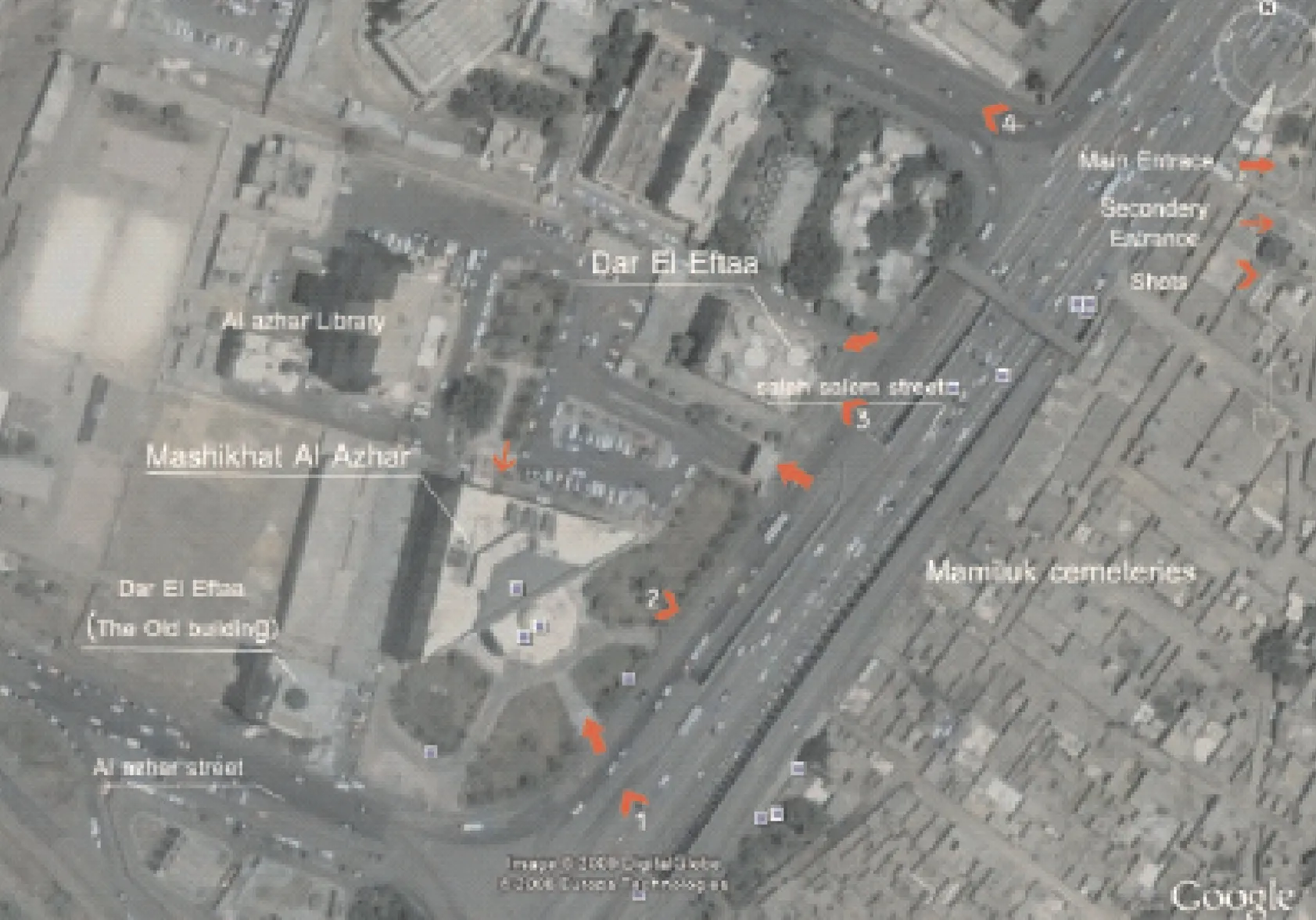
(a)
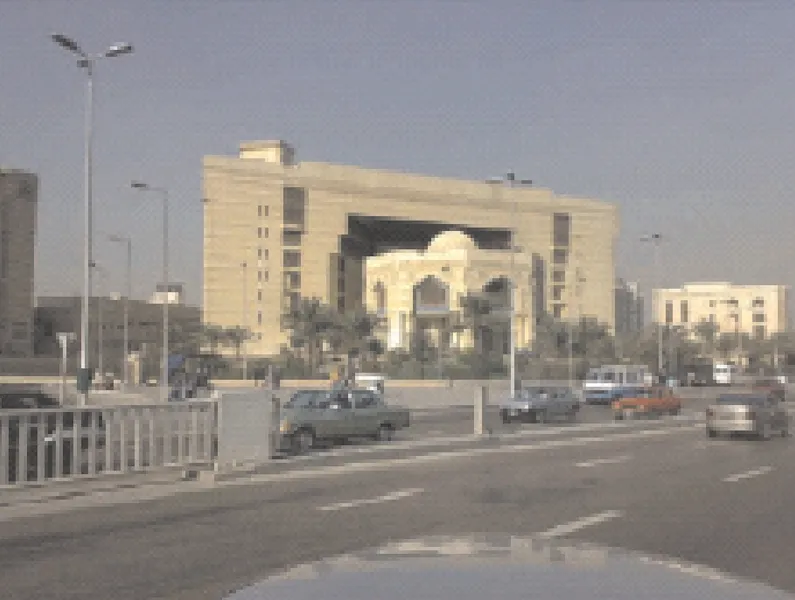
(b)

(c)

(d)

(e)
Fig.6 Site plan of the compound of Mashiakhet Al Azhar and Dar El Eftaa satellite image, and terrestrial shots of the surrounding streets and buildings
5.1 Elements of Mashiakhet Al Azhar
The building is an administrational construction occupying an area of 6000 m2with dimensions of 1.8×104m2. It is composed of 8 stories to accommodate the various administrations according to the program of its utilitarian needs and functions(see Fig.7).

Fig.7 Design elements of Mashiakhet Al Azhar building on the ground and first floors
5.2 Elements of Dar El Eftaa
This is essentially an administrational building, where consultant services are offered to citizens and authorities. Its area is about 2000 m2, and it is composed of five stories. The administration offices are accommodated according to the sequence of functions. The internal courtyard is used as a prayer yard surrounded by lateral courts. The office of Mufti (Azharian Sheikh) occupies a central and special location at the main facade facing outside via a magnificent Mashrabia (a famous Mamiluk architectural element representing the modern balcony) (see Fig.8).
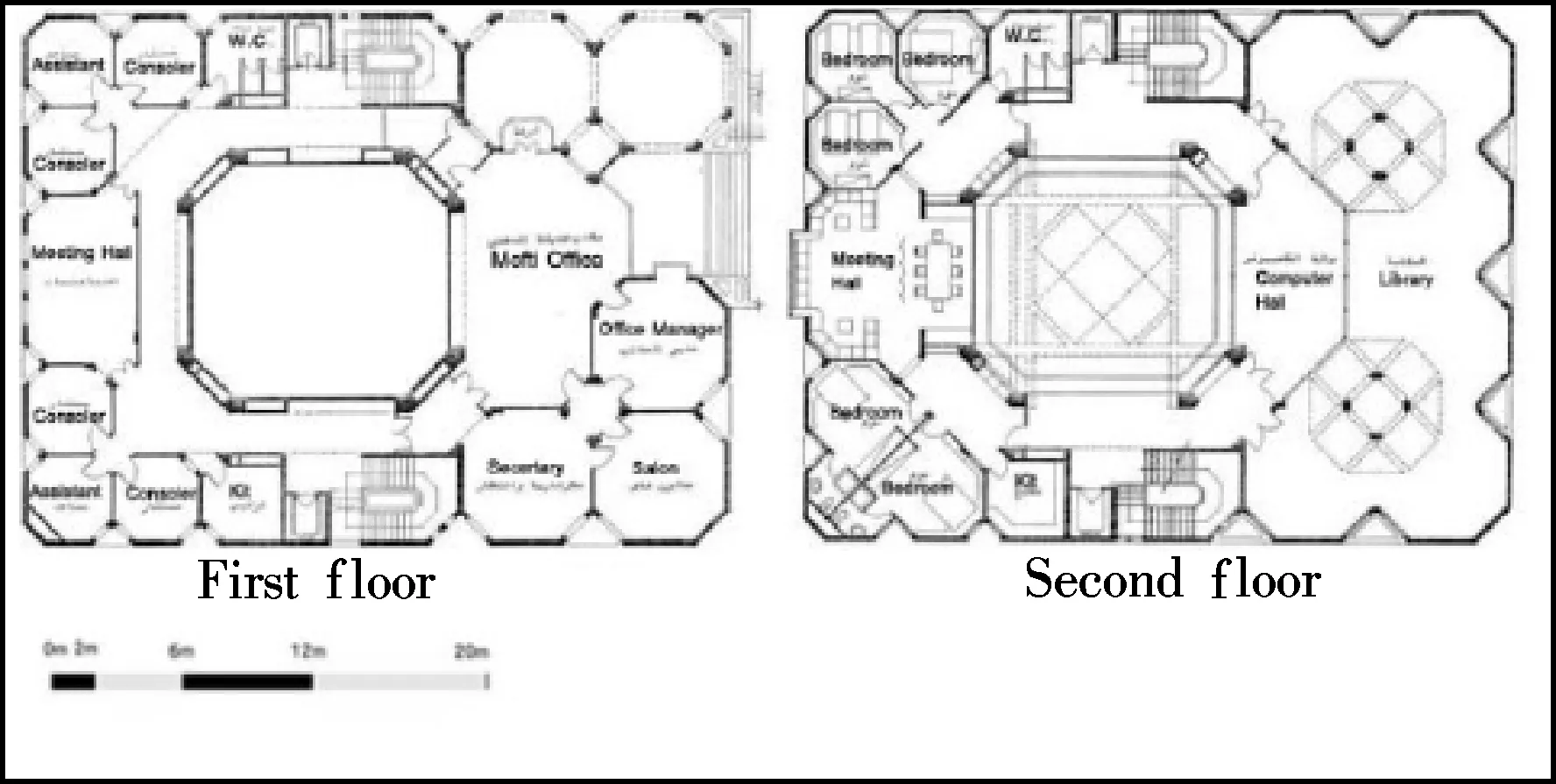
Fig.8 Design elements of the El Eftaa building on the first and second floors
5.3 Conceptual design
The conceptual design of these two constructions is compatible with the Islamic heritage of the Mamiluk Cairo. The concept adopted by the designer(ABDTC, Local Bureau) depended on achieving an Islamic style in a modern and contemporary spirit, integrating at the same time with many surrounding Islamic buildings and a historical landscape. It incorporates the common elements of the Fatimid and Mamiluk monuments nearby.
6 A Comparative Analytical Study of Architectural Forms and Elements in the Three Institutions
6.1 External facades
All outside facades of the hospital are mainly of glass, giving an impression of transparency from a distance which is strongly contradictory with the Islamic design concept of external facades. These have fewer openings looking outside while the main and important openings are looking over internal courtyards, which meet the important Islamic principle of privacy. The design of both the Mashiakhat Al Azhar and Dar El Eftaa wonderfully represents this preceding principle(see Fig.9).

(a)

(b)

(c)
6.2 Openings
Due to the extensive surface areas of the openings of the facades of the hospital, sun rays and glare become a problem in day time due to the wide spaces in the structure. To overcome this obstacle, heavy curtains and double glass sheets with argon gas inbetween them as a filter of harmful sun rays are essential in cancer treatment for the children who are exposed to radiation and chemotherapy. The use of wide glass planes did not result in successful heat insulation. Accordingly, the hospital is using mechanical and electrical means in all times to achieve the previous objectives(see Fig.10).
6.3 The entrance
Since Islamic architecture has a common characteristic style, concerning the main entrances which are generally with almost the same height of the building or the first floor, this entrance design is strong and assertive. In an Islamic compound like Al Azhar, the two institutions are designed with this style of entrances at the front, facing onto the main streets. Every entrance is clear and lintel-led with a pointed arch.

(a)

(b)
Fig.10 The glare from extensive use of wide glass openings in patient room and the patient room curtains
However, in the hospital case, metal structures were used to define and reinforce the main entrances. Other entrances are simple and usually have front and intermediate glass doors (see Fig.11).

(a)

(b)
Fig.11 Extensive use of wide glass at the entrance and the wide open glass floors space design
6.4 Elements of structural form (columns, domes andarches)
Islamic architecture in the vicinity has known to embrace important and characteristic structural elements. Columns are one of these elements and were adopted in the earlier decades of Islam from Churches and Temples (Abd El Gawad, 1987)[5]. In later periods, the columns were modified, particularly during the Mamiluk Dynasty and exhibited elaborate forms. The designer of those Islamic institutions inspired different forms of columns using modern materials for coating, such as marble and some other manufactured materials. Dome elements were successfully used to cover the bulk of the main building. Also Aqoud (Arches) of Islamic style was used in similar scales during the Fatimid and Mamluk Dynasty with some modifications to give a contemporary style to the construction (see Fig.12).
However, in the hospital building case, a different concept and culture were adopted by the designer, who used a spherical form of glass and metal structures, for instance. He used these forms as constructional forms and as decorative patterns, which are not compatible with the style of the surroundings.
6.5 Internal facades
The design of the Islamic institutions depended on dec-orating the external facades with Islamic elements, as well as in the internal facades, using calligraphic patterns excessively. Mashrabiat and wooden arabesque are used to decorate the large openings in different facades. Marbles with geometric patterns and different colors are used in floors and walls. Ceilings are decorated with geometric units and colour finishing materials. Carpets and furniture decorated with Islamic repetitive patterns were spread in courtyards and reception halls. Yet for the hospital interiors, imported materials are used to cover walls and floors. Finishing materials used in covering walls are chemical products treated to resist bacteria and microbes[6]. These materials and treatments could be used in the interiors of the Islamic constructions without contradiction and could be modified to be in harmony with the Islamic spirit (see Fig.13).

(a)

(b)

(c)
7 Results and Discussions
All aspects such as the arch science of architecture of the traditional Islamic and the modern design have to achieve complete harmony with the surrounding environments. The Hospital meets its utilitarian needs and functions, but lacks a general environmental and traditional balance with the whole district. Functional and traditional aspects, however, can be combined successfully at the same time. It is the task and the art of the designers to develop certain Islamic elements to fit the purpose of the construction. The reaction of local designers with the traditional and environmental requirements is noticed in many other establishments. The hospital is located in the expansion districts of Cairo. There is a certain need to be present in the area; it should be compatible with its environment as well as Islamic traditional designs. The location of such a critical and highly sophisticated institution is greatly at odds with environmental and traditional requirements.

(b)
8 Conclusion
A complete compatibility with the environmental and traditional aspects is a challenge facing the designer who is also striving for the application of technological advancements in the relevant fields. The contradiction between the two cultures, the traditional and the contemporary, would call upon the architect to neglect one for the other. Environmental and traditional aspects should be carefully considered when great and important projects are to be implemented in the city. Different designs of a project should be displayed to the public for discussion and evaluation. Local architects are called for their role and duty in harmonizing between technological and traditional requirements. The advantage of cooperation and assistance with foreign experience was sought in the application of modern technology within a frame of an integrated system, satisfying both traditional and environmental needs. Architectural competition in important projects of national interest should necessarily be organized for this purpose.
[1]Center for Planning and Architectural Studies. Principles of architectural design and urban planning during different Islamic Eras[S]. KSA: Islamic Studies,1992.
[2]Clevenot D, Degeorge G, Hudsonltd T.OrnamentsanddecorationinIslamicarchitecture[M].London: Vendom Press, 2000.
[3]Amin M M, Ibrahim A L.ArchitecturaltermsinMamilukdocuments[M].Cario, Egypt: The American University in Cairo, Egypt, 1990.
[4]Hoaa J D.Islamicarchitecture[M]. New York: INC Publishers, 1977.
[5]Abd El Gawad A T.Islamicarchitecture[M].Cairo, Egypt: Anglo Llibrary, 1987. (in Arabic)
[6]Mohammad H. The new hospital design[J].Tasmeem, 2008, 18(4): 22-29. (in Arabic)
与伊斯兰传统建筑环境重叠的现代建筑设计
Ma Albeetar Rami
(东南大学建筑学院, 南京 210096)
从生态环境的角度分析建筑物的功能和伊斯兰文化、环境之间的兼容性.所面临的挑战是如何使传统的外形最大程度上适应建筑物的功能和本来的用途,以及新的建筑物如何满足传统环境的要求.研究还表明,目前医院建筑中越来越多地使用现代设计材料,但这些材料并不能提供足够的保温隔热和适当的照明.而Mashikha Al Azhar和Dar El Eftaa的建立有完全不同的功能,其设计考虑和认识到了环保需求和历史背景.MashikhaAl Azhar和Dar El Eftaa的场地已经与周边环境达到完全的和谐.医院可能有非常适合的功利性需求和功能,但缺乏与整个小区整体环境和传统的平衡,然而功能和传统应该成功地同时满足.
伊斯兰环境; 历史景观; 传统轮廓和环境要求
TU2
:Ma Albeetar Rami.Islamic traditional architecture environment overlapping the modern architecture design[J].Journal of Southeast University (English Edition),2014,30(3):396-402.
10.3969/j.issn.1003-7985.2014.03.026
10.3969/j.issn.1003-7985.2014.03.026
Received 2014-03-11.
Biography:Ma Albeetar Rami(1977—), male, graduate, Ramyy2004@yahoo.com.
 Journal of Southeast University(English Edition)2014年3期
Journal of Southeast University(English Edition)2014年3期
- Journal of Southeast University(English Edition)的其它文章
- Observation and characterization of asphalt microstructure by atomic force microscopy
- Research on asphalt concrete pavement deicing technology
- Influence of different curing regimes on the microstructure and macro performance of UHPFRCC
- Evil-hunter: a novel web shell detection system based on scoring scheme
- Intelligibility evaluation of enhanced whisper in joint time-frequency domain
- Hom-dimodules and FRT theorem of Hom type
